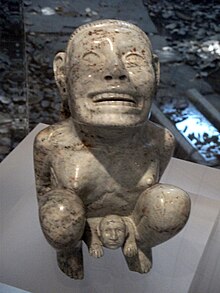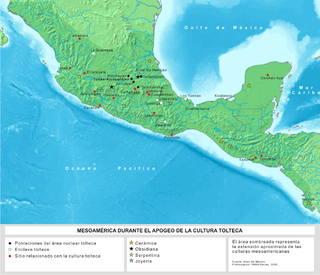
The Toltec culture was a pre-Columbian Mesoamerican culture that ruled a state centered in Tula, Hidalgo, Mexico, during the Epiclassic and the early Post-Classic period of Mesoamerican chronology, reaching prominence from 950 to 1150 CE. The later Aztec culture considered the Toltec to be their intellectual and cultural predecessors and described Toltec culture emanating from Tōllān as the epitome of civilization. In the Nahuatl language the word Tōltēkatl (singular) or Tōltēkah (plural) came to take on the meaning "artisan". The Aztec oral and pictographic tradition also described the history of the Toltec Empire, giving lists of rulers and their exploits.
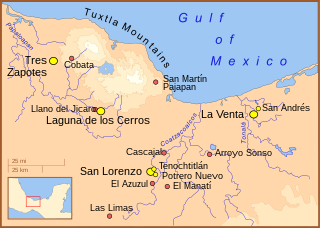
The Olmecs were the earliest known major Mesoamerican civilization. Following a progressive development in Soconusco, they occupied the tropical lowlands of the modern-day Mexican states of Veracruz and Tabasco. It has been speculated that the Olmecs derived in part from the neighboring Mokaya or Mixe–Zoque cultures.

Tlaltecuhtli is a pre-Columbian Mesoamerican deity worshipped primarily by the Mexica (Aztec) people. Sometimes referred to as the "earth monster," Tlaltecuhtli's dismembered body was the basis for the world in the Aztec creation story of the fifth and final cosmos. In carvings, Tlaltecuhtli is often depicted as an anthropomorphic being with splayed arms and legs. Considered the source of all living things, he had to be kept sated by human sacrifices which would ensure the continued order of the world.
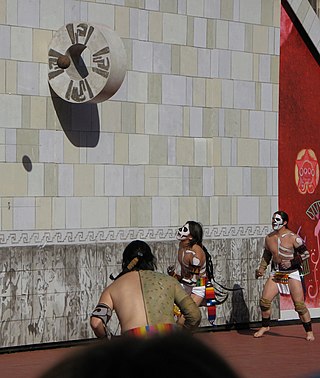
The Mesoamerican ballgame was a sport with ritual associations played since at least 1650 BC by the pre-Columbian people of Ancient Mesoamerica. The sport had different versions in different places during the millennia, and a modernized version of the game, ulama, is still played by the indigenous populations in some places.

Crystal skulls are human skull hardstone carvings made of clear or milky white quartz, claimed to be pre-Columbian Mesoamerican artifacts by their alleged finders; however, these claims have been refuted for all of the specimens made available for scientific studies. The results of these studies demonstrated that those examined were manufactured in the mid-19th century or later, almost certainly in Europe, during a time when interest in ancient culture abounded. The skulls appear to have been crafted in Germany, quite likely at workshops in the town of Idar-Oberstein, which was renowned for crafting objects made from imported Brazilian quartz in the late 19th century.

Dumbarton Oaks, formally the Dumbarton Oaks Research Library and Collection, is a historic estate in the Georgetown neighborhood of Washington, D.C. It was the residence and gardens of wealthy U.S. diplomat Robert Woods Bliss and his wife Mildred Barnes Bliss. The estate was founded by the Bliss couple, who gave the home and gardens to Harvard University in 1940. In 1944, it was the site of the Dumbarton Oaks Conference to plan for the post-WWII United Nations. The part of the landscaped portion of the estate that was designed as an enhanced "natural" area, was given to the National Park Service and is now Dumbarton Oaks Park.
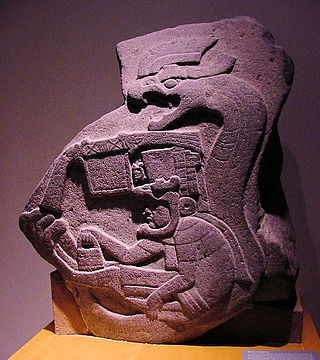
The religion of the Olmec people significantly influenced the social development and mythological world view of Mesoamerica. Scholars have seen echoes of Olmec supernatural in the subsequent religions and mythologies of nearly all later pre-Columbian era cultures.
Below are notable events in archaeology that occurred in 1899.
Below are notable events in archaeology that occurred in 1906.

The National Museum of Anthropology is a national museum of Mexico. It is the largest and most visited museum in Mexico. Located in the area between Paseo de la Reforma and Mahatma Gandhi Street within Chapultepec Park in Mexico City, the museum contains significant archaeological and anthropological artifacts from Mexico's pre-Columbian heritage, such as the Stone of the Sun and the Aztec Xochipilli statue.
George Alexander Kubler was an American art historian and among the foremost scholars on the art of Pre-Columbian America and Ibero-American Art.
Ross Hassig is an American historical anthropologist specializing in Mesoamerican studies, particularly the Aztec culture. His focus is often on the description of practical infrastructure in Mesoamerican societies. He is the author of several influential books, among them: Time, History, and Belief in Aztec and Colonial Mexico; Aztec Warfare: Imperial Expansion and Political Control; and Trade, Tribute, and Transportation: The Sixteenth-Century Political Economy of the Valley of Mexico.
Henry Bigger Nicholson who published under the name H.B. Nicholson, was a scholar of the Aztecs. His major scholarly monograph is Topiltzin Quetzalcoatl: The Once and Future Lord of the Toltecs (2001).

Eugène Boban or Boban-Duvergé (1834–1908) was a French antiquarian. He was the official archaeologist of the court of Maximilian I of Mexico, and a member of the French Scientific Commission in Mexico. From time to time he sold crystal skulls, one which is now in the Musée du Quai Branly and another in the British Museum.
Elizabeth Hill Boone is an American art historian, ethnohistorian and academic, specializing in the study of Latin American art and in particular the early colonial and pre-Columbian art, iconography and pictorial codices associated with the Mixtec, Aztec and other Mesoamerican cultures in the central Mexican region. Her extensive published research covers investigations into the nature of Aztec writing, the symbolism and structure of Aztec art and iconography and the interpretation of Mixtec and Aztec codices.
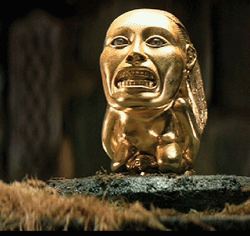
The Chachapoyan Fertility Idol, more commonly referred to as the Golden Idol, is a fictitious artifact that appears in the opening sequence of the 1981 film Raiders of the Lost Ark, the first entry in the Indiana Jones franchise created by George Lucas. It is the first relic that the audience sees the protagonist Indiana Jones acquire, establishing him as a treasure hunter. The idol's likeness has become iconic in popular culture.
Elizabeth P. Benson was an American art historian, curator and scholar, known for her extensive contributions over a long career to the study of pre-Columbian art, in particular that of Mesoamerica and the Andes. A former "Andrew S. Keck Distinguished Visiting Professor of Art History" at the American University in Washington, D.C., Benson had also a long association with the Dumbarton Oaks Research Library and Collection, where she served both as director of Pre-Columbian studies and as curator of the institution's collection of Pre-Columbian artworks. Benson was born in May 1924 and died in Washington D.C. in March 2018 at the age of 93.
Jane MacLaren Walsh is an anthropologist and researcher at the Smithsonian's National Museum of Natural History in Washington, D.C. She is known for her role in exposing faked pre-Columbian artifacts.

The use of mirrors in Mesoamerican culture was associated with the idea that they served as portals to a realm that could be seen but not interacted with. Mirrors in pre-Columbian Mesoamerica were fashioned from stone and served a number of uses, from the decorative to the divinatory. An ancient tradition among many Mesoamerican cultures was the practice of divination using the surface of a bowl of water as a mirror. At the time of the Spanish conquest this form of divination was still practiced among the Maya, Aztecs and Purépecha. In Mesoamerican art, mirrors are frequently associated with pools of liquid; this liquid was likely to have been water.
Pál Kelemen was a Hungarian-American archaeologist, art historian, and international art lecturer who contributed to the research of Pre-Columbian art. Kelemen was one of the first to recognize the importance of medieval Spanish colonial artwork of the Americas. Kelemen received the Order of Merit from the government of Ecuador.
